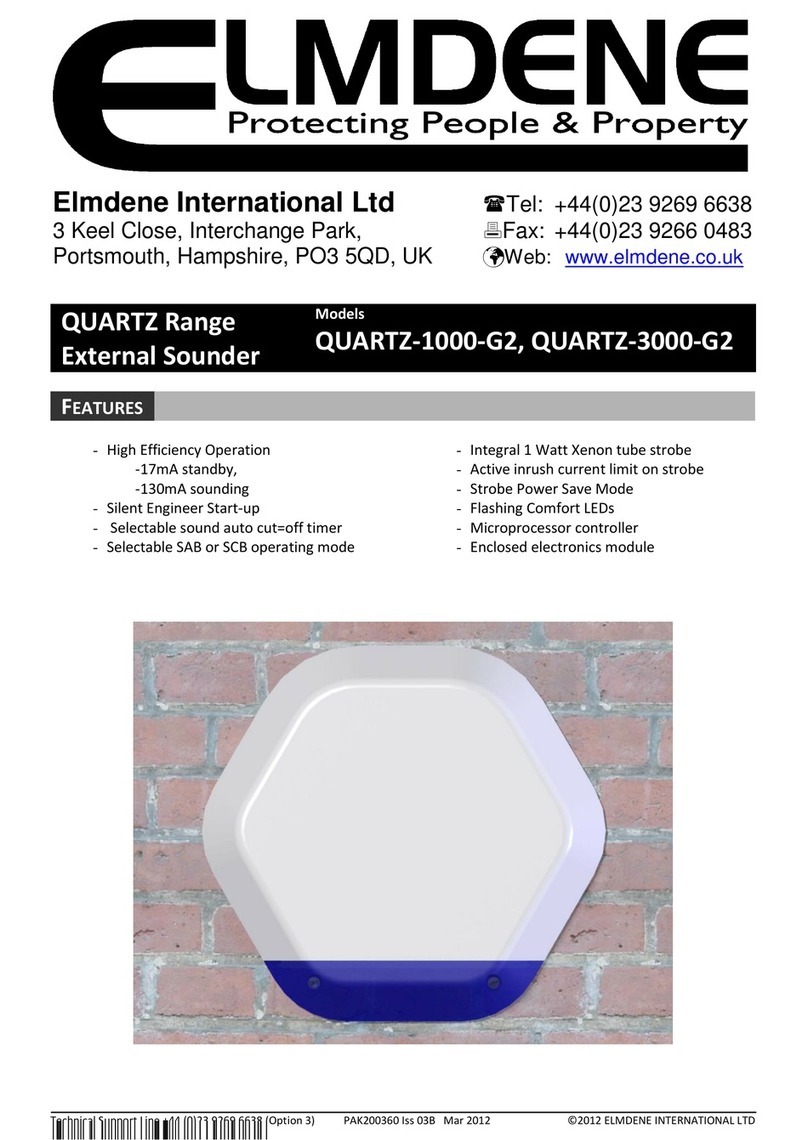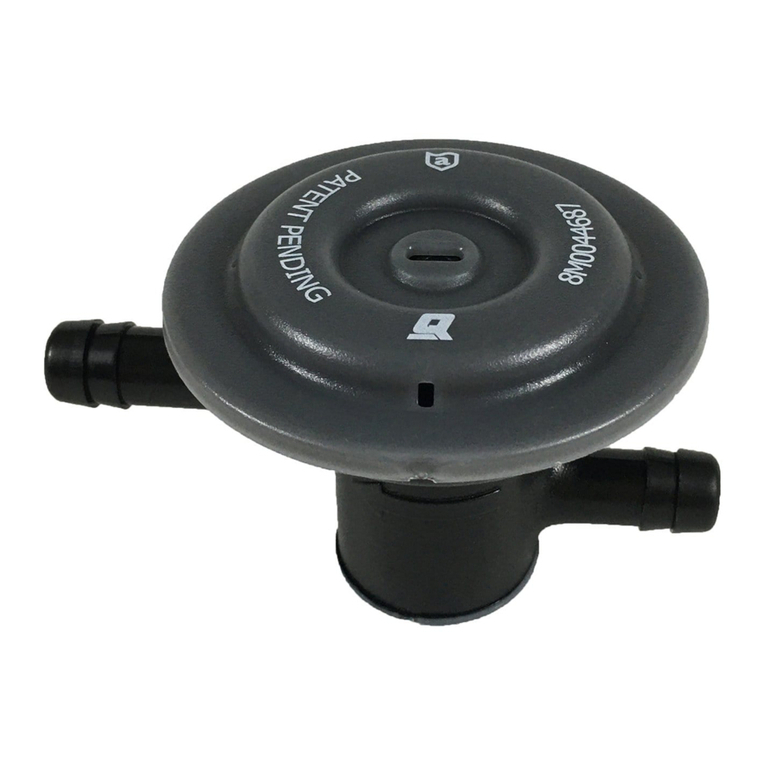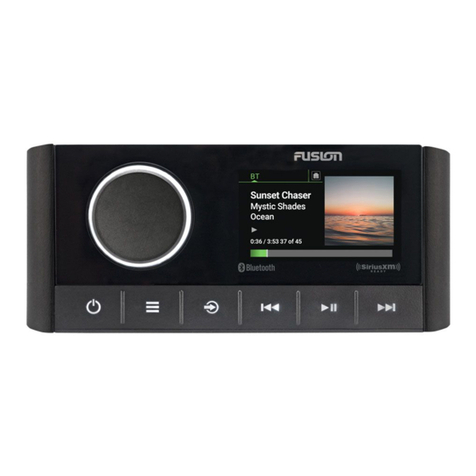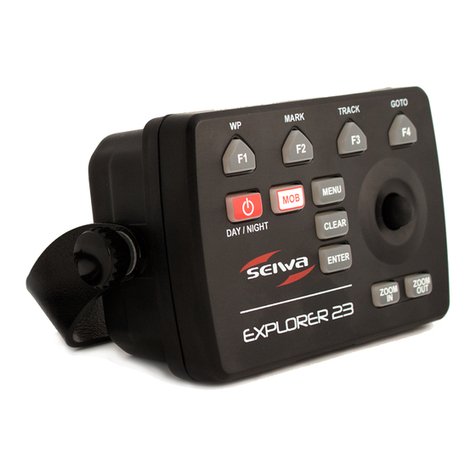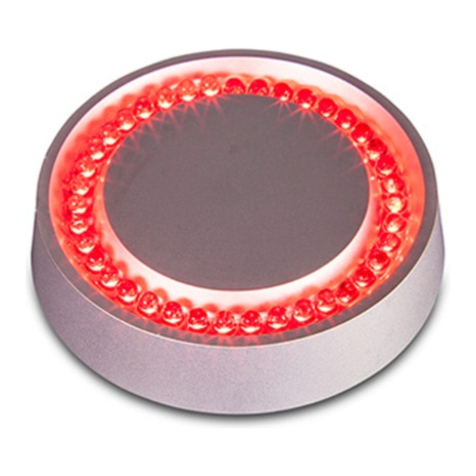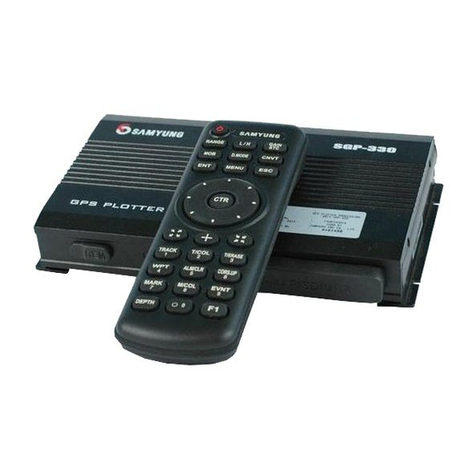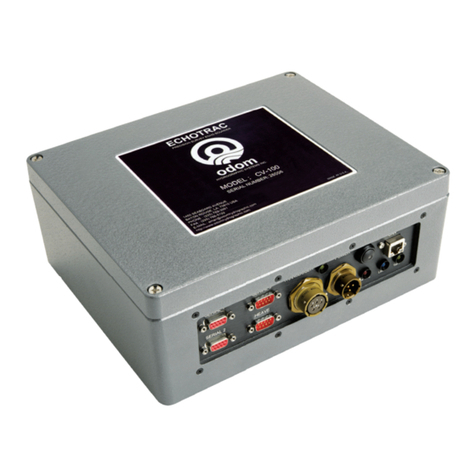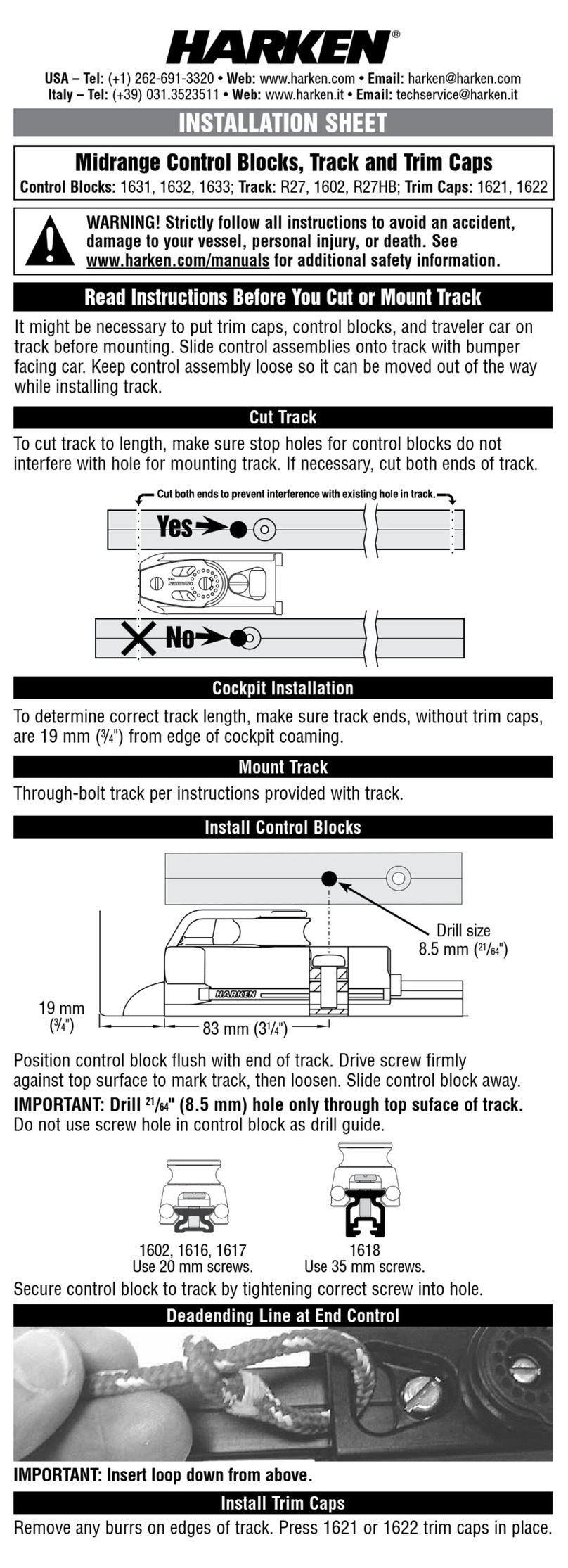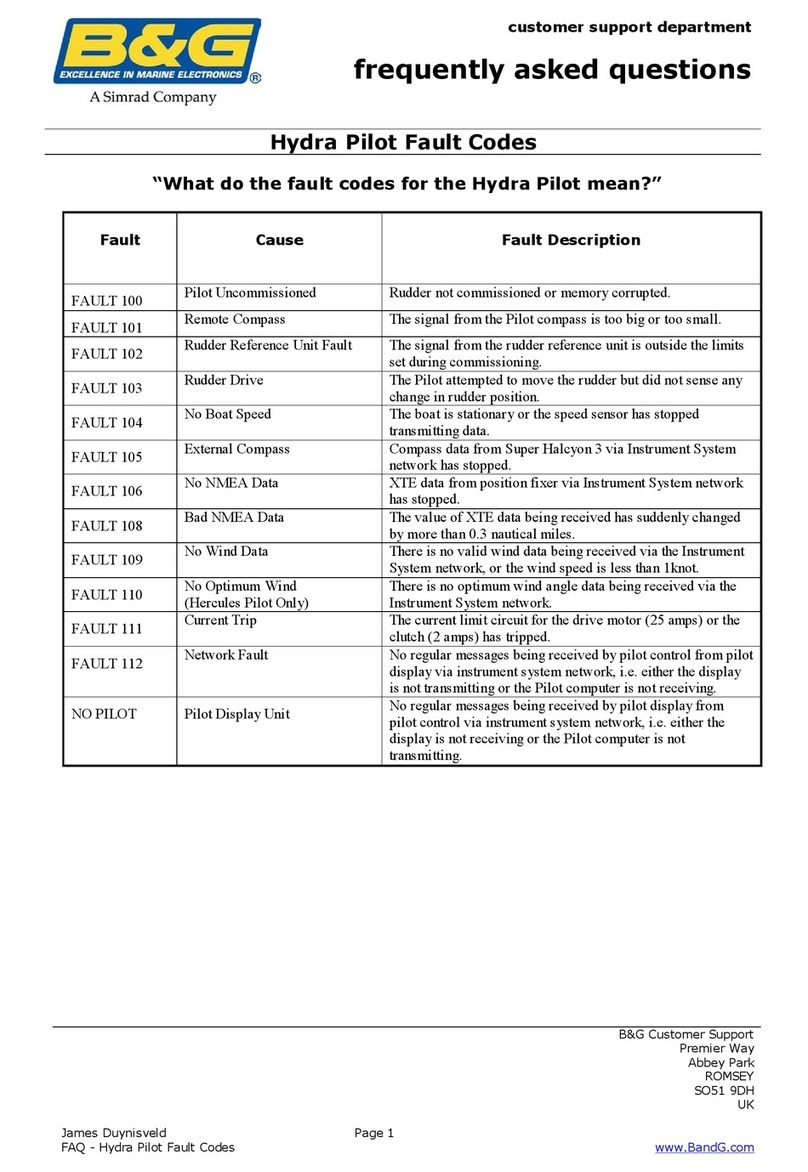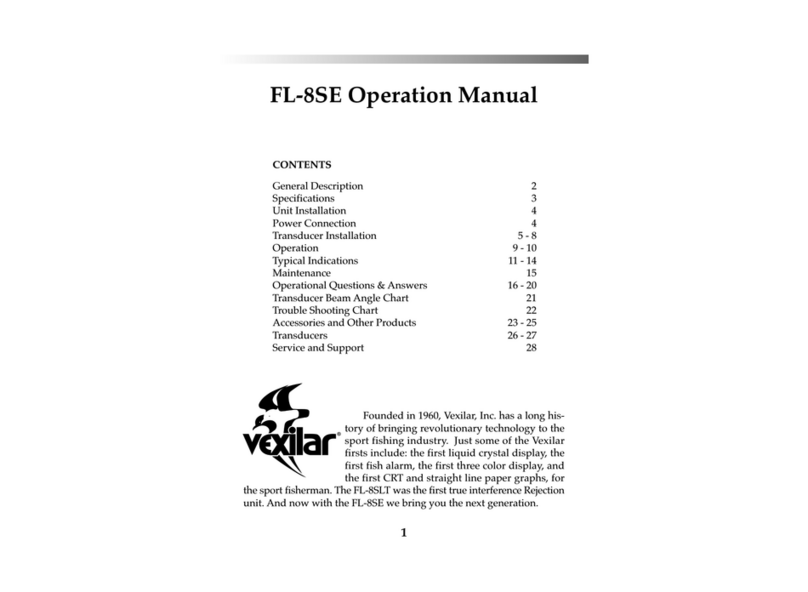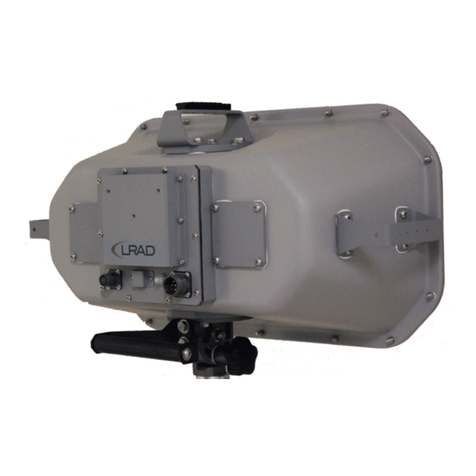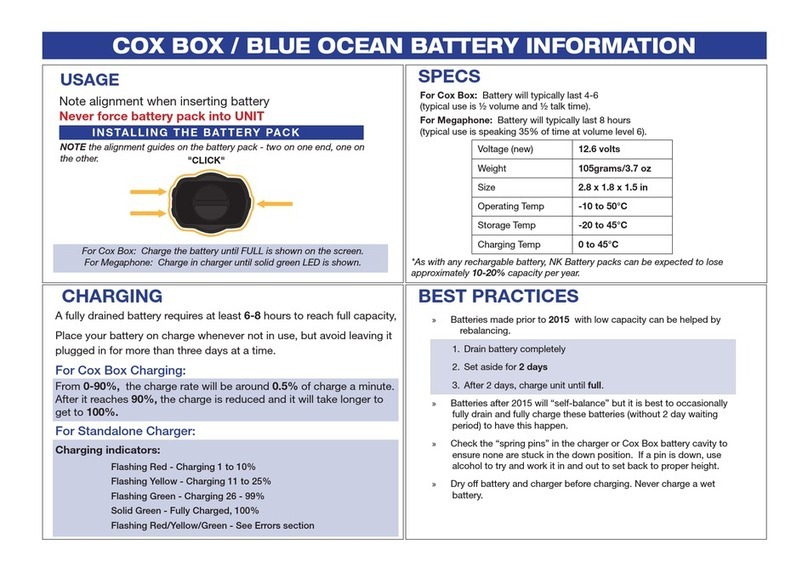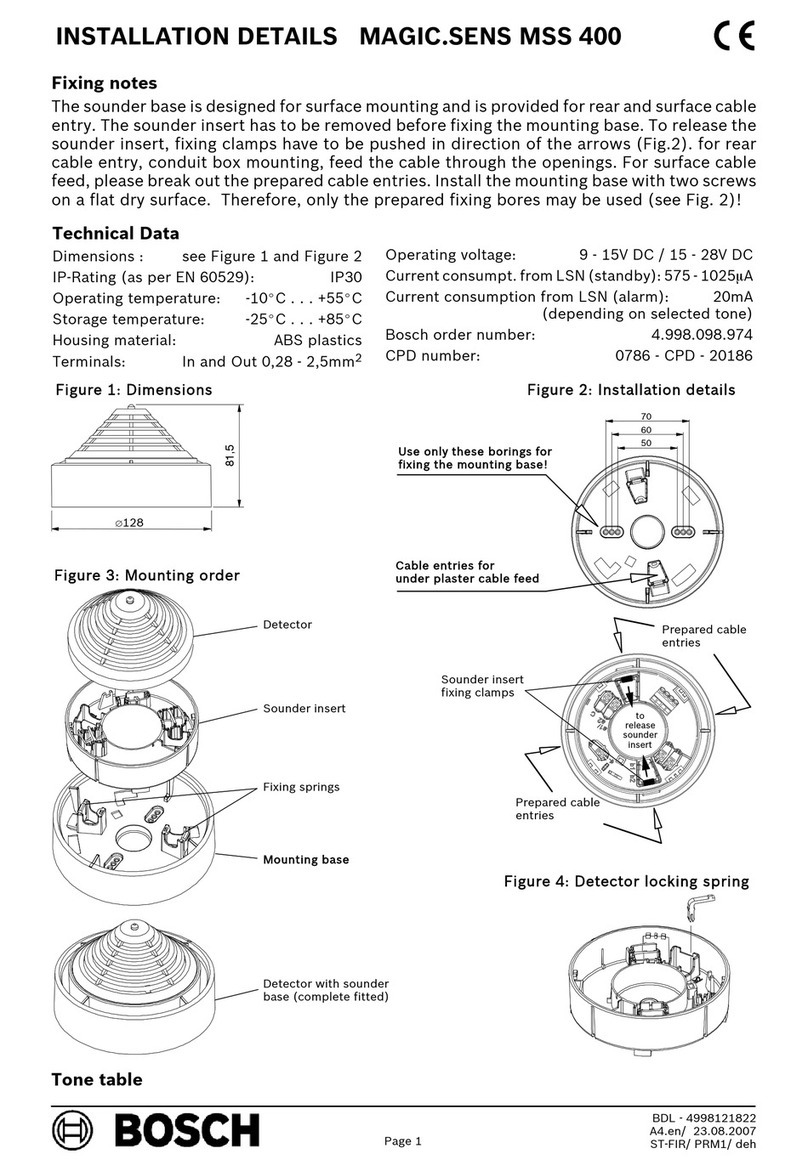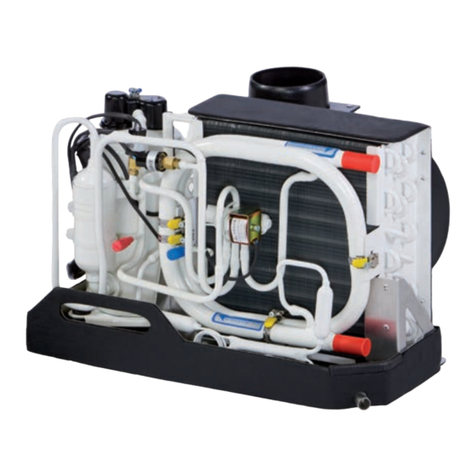Sea Marshall AU9 User manual

Page 1of 38

Page 2of 38
The Sea Marshall® brand derives its name from David Marshall, the man who invented the
concept of the Personal Locator Beacon for commercial use back in the early 1970s. Marine
Rescue Technologies Ltd. today retains its founding roots as a thriving familly owned enterprise
manufacturing and selling the award winning Sea Marshall® Maritime Survivor Locating Devices
into the following markets, world-wide.
Commercial
Commercial Marine and Commercial Fishing; the Sea Marshall® system has been adopted by
the Spanish Fishing Fleets as part of legislation requiring all fishing vessels to carry a self
managed man overboard system.
Renewable energy
Offshore windfarm operators are using the Sea Marshall® system on a daily basis as part of the
HSE requirement for safety when working on offshore windfarms.
Yachting
The Sea Marshall® MOB system is used by a number of the world’s superyachts and sport
sailors.
Oil & Gas
The ATEX (Intrinsically Safe) version of the Sea Marshall® system is used extensively throughout
the Oil & Gas industry worldwide.
Helicopter Transit
We are pleased to announce the launch of the helicopter specific Sea Marshall® AU9-HT high
power personal locator beacon for use in passenger transit to offshore installations.
ED-14F environmentally tested (part), CAA.
Aquaculture
We are pleased to say that Marine Harvest are amongst the first of the global fish farm operators
to be using the Sea Marshall® unmanned man overboard monitoring system.
Dive
Commercial and Leisure, a growing number of private divers and commercial dive boat operators
are using the Sea Marshall® lost diver locating system on a daily basis.
Submariner
The pressure proof (300m) Sea Marshall® submarine PLB is in use with a growing number of the
world’s navies.

Page 3of 38
Document description - AU9 Operators Guide
Document number –0106-09
Revision number –006
Last updated –Monday 1st June 2010
Updated By –Andrew Brown
Contents
Pages
Description
Page 4
Declaration Of Conformity
Page 5
AU9 overview
Page 6 - 9
Background & Specifications
Page 10-26
Man overboard use
10
Arming the AU9 ready for MOB use
11
How to activate the unit when it is armed
12-15
Switching the unit OFF
Testing the AU9
Battery check & change procedure
16-25
Wearing the AU9
How to fit the AU9 into a lifejacket
26
Anti-tamper cap
AU9 Maintenance
Page 27-34
DIVE use
27
AU9 Dive Conversion Kit
28,30
Fitting the pressure cap
31
How often should I re-seal my unit?
Using the AU9 with prtessure cap fitted
32
Initiating an Emergency ‘SOS’ transmission with AU9
Dive Conversion Kit fitted
33,34
Using your AU9 with a surface marker bouy and diver
locating system
35
Wearing the AU9 with Dive Conversion Kit fitted
35
AU9 DIVE Maintenance
Page 36,37
36,37
High Power ‘500mW’ version of AU9
Page 38
38
Warranty
Disclaimer

Page 4of 38
Declaration of Conformity
Name of Manufacturer/Eu importer
Marine Rescue Technologies ltd.
Units 3 & 4, Front Street Court,
Middleton On The Wolds,
East Yorkshire, YO25 9TZ
United Kingdom
www.seamarshall.com
Declares that products:
AU9-HT, AU9-X and AU9
Personnel Locator Beacons
Conforms to the R&TTE Directive 1999/5/EC as attested by conformity
with the following harmonized standards:
EN 300 152-2 V1.1.1:
Electromagnetic compatibility and Radio spectrum Matters (ERM);
Maritime Emergency Position Indicating Radio Beacons (EPIRBs)
intended for use on the frequency 121,5 MHz or the frequencies 121,5
MHz and 243 MHz for homing purposes only; Part 2: Harmonized EN
under article 3.2 of the R&TTE Directive.
(Article 3.2)
EN 300 152-3 V1.1.1:
Electromagnetic compatibility and Radio spectrum
Matters (ERM); Maritime Emergency Position
Indicating Radio Beacons (EPIRBs) intended for use
on the frequency 121,5 MHz or the frequencies
121,5 MHz and 243 MHz for homing purposes only;
Part 3: Harmonized EN under article 3.3e of the
R&TTE Directive.
(Article 3.3)
Conform to the Low Voltage Directive 2006/95/EC as attested
by conformity with the following harmonized standard:
EN60950-1:2006:
Information technology equipment —Safety —Part 1: General requirements.
Signed
Name
David Marshall
Position
Chairman
Date
September 2009
FCC ID –YFGAU9

Page 5of 38
1.0 AU9 OVERVIEW
The Sea Marshall® AU9, Alerting Unit series 9, has been designed to fullfill the requirement of the
Marine Industry for a long lasting, high quality, robust, high powered 121.5MHz locator beacon for Man
Overboard/Lost Diver Alert & Locate. The AU9 is derived from the well known PLB8 series of Sea
Marshall® personal locator beacon, it utilises the same format of operation so as to retain some
consistency of user familiarity and function in the field. In all other respects the AU9 unit is a completely
new and much more advanced unit. The AU9 is available in two power ouptuts, 100mW and 500mW by
special order. (The 500mW has approximately double the tracking range of the 100mW version).
Fig. 1

Page 6of 38
1.1.1 BACKGROUND
Fig. 2 A (NOTE –100mW version of the AU9 has approximately half the tracking range of the 500mW unit)
Fig. 2 B
NOTE –the tracking ranges listed are taken from tests where the receiver antenna has been correctly installed at the recommended height
with the AU9 correctly installed in either an SMB for divers or lifejacket, with antenna clip for normal use. The SMB gave the maximum range
listed as achieved during tests, the lifejacket AU9 installation gave the lower end of the ranges listed. Wearing the AU9 around the neck will
reduce the tracking/alerting ranges to below the ranges listed here in.

Page 7of 38
1.1.2 AU9 SPECIFICATIONS
Frequency: 121.5 MHz
Bandwidth 25KHz (in alignmnet with ETSI)
Battery: 2 × 3V lithium CR AA (K) pack, user replaceable.
Battery 10 year full life (replace after 5 years or after use, which ever is sooner)
Endurance: Average 100mW = 42hours, 500mW = 24 hours
(60 months ‘approx’ on standby/armed)
Dimensions : 90mm high × 70mm wide(body) 80mm hinge/base cap × 35mm deep
Modulation: Continuous swept tone A3X
Output power: 100mW or 500mmW
Temp range (storage): -55°C to + 70°C;
Approvals –CE
Test Units: 121.65MHz and 121.775MHz
Activation - Manual & Automatic with manual override (salt and fresh water)
NOTE: some units have a fail-safe over ride function installed to allow the unit to auto-activate in
the vent the unit has been switched off.
Diver pressure cap conversion kit available = pressure proof to 100m depth
Antenna: 1m cable with flexible helical spring section, adaptable for lifejacket fitting
Strobe: inbuilt LED strobe on antenna flashes ‘SOS’.
ILS: internal loudspeaker 80dB
Weigth: 250gms (approx)
Waterproofing –IP-68
Environmental –the AU9 has passed the following environmental tests from Eurocae ED-14F
Temperature & altitude
Temperature variation
Humidity
Shock & crash safety
Explosive atmosphere
Waterproofness
Sand & Dust
Salt Fog
Magnetic Effect
RF –Susceptibility
Icing
ESD

Page 8of 38
1.2.0 OPERATING THE AU9 FOR MAN OVERBOARD SAFETY COVER
1.2.1 The following sections cover how to use your AU9 unit on a day to day basis for Man Overboard
safety cover. Your AU9 can be used as part of a Sea Marshall® self managed Man Overboard Alert &
Locate system known as a Maritime Survivor Locating Device; utilising one of the two Sea Marshall®
Base Unit receiver options listed below:
1. ‘CREWGUARD’ GPS PLOT MOB ALARM –MOB monitor/alarm which automatically plots the GPS
position of the vessel at the time the person fell overboard. The person in the water can be tracked on
the international SAR homing frequency of 121.5MHz by Coast Guard SAR. A low cost safety solution
providing essential cover for your crew/passengers.
Fig. 3
Fig. 4

Page 9of 38
2. SARfinder® GPS PLOT MOB ALARM AND LOCATE HOMING UNIT –MOB monitor/alarm/homing
unit which automatically plots the postion of the vessel at the time the person fell overboard, the
SARfinder® also shows the direction of the ‘SOS’ signal and the approximate range of the target on it’s
easy to read compass style display.
Fig. 5
Fig. 6

Page 10 of 38
1.2.2 ARMING THE AU9 –making the unit ready for both manual and auto-activation. A quick reminder
label is attached to the rear of your AU9 unit.
Fig. 7
Slide the side arming switch DOWN (no. 11, refer to Fig 1. on page 5). This is done by lifting the rubber
restrainer ‘O’ ring (no. 6) up and over the side switch, manually pushing the side switch (no. 11) down
until it positively clicks and then letting the ‘O’ ring sit back in the gap above the side switch. The unit
will ‘BEEP’ 3 times to let you know it has been armed. THE UNIT IS NOW ARMED and the green LED will
flash every 3 seconds (continuously) to show the unit is armed and the battery is engaged; it can now be
activated for full power transmission by one of two methods:
1. Manually by pressing the round rubber activation button on the front (12 on fig.1)
2. Automatically after 5 seconds of constant immersion in water, salt or fresh; water sensor pins 3 &
9 on fig.1.
NOTE - For units fitted with 40 second override function the unit can also be automatically activated
after 40 seconds of constant immersion in water, salt or fresh; water sensor pins 3 & 9 on fig.1.
Fig. 8

Page 11 of 38
1.3.0 HOW TO ACTIVATE THE AU9 WHEN IT IS ARMED-READY
To start full power transmission the following operations have to take place:
1.3.1 When the unit is ARMED the user firmly presses the round rubber button on the front of the unit
(no 10). The unit will now transmit continuously until switched off by moving the side Arming Switch
(no. 11) UP until it positively clicks.
Fig. 9
1.3.2 Alternatively for automatic activation the user enters the water, after 5 seconds of continuous
immersion the unit will self activate and transmit continuously until switched off by moving the side
Arming Switch (no. 11) UP until it clicks, the unit will ‘BEEP’ and stop transmitting after a few seconds.
Fig. 10
NOTE –The unit has two waterpin sensors, (no. 3 & 9), both these sensors have to be continuously
immersed for a period of not less than 5 seconds to allow the unit to wake up and auto-activate, this
prevents inadvertent activation by spray, rain, splash.

Page 12 of 38
1.3.3 What happens when the unit is transmitting on full power? The unit will make a BEEPING sound
and the antenna LED section will flash GREEN, followed by flashing RED LEDs in an SOS pattern this will
continuously cycle until the unit is switched off.
1.4.0 SWITCHING THE AU9 OFF –DISENGAGING THE BATTERY
Fig. 11
1.4.1 Lift the rubber ‘O’ ring (no. 6) out and down, slide the side switch (no. 11) UP until it clicks. The
unit will stop transmitting within a few seconds, the unit will ‘BEEP’ once to indicate it has been
switched OFF.
1.4.2 SWITCHING THE UNIT OFF FROM AUTOMATIC OVER RIDE ACTIVATION - The unit will continue to
transmitt on full power until manually switched OFF by moving the side ARMING switch DOWN & then
immedaitely back UP until it positively clicks. Applies to units fitted with 40 second override function
only, the instruction label on the rear of your unit will indicate if your unit has this function installed
or not
Fig. 12

Page 13 of 38
1.5.0 TESTING THE AU9 –TRANSMISSION & BATTERY
Fig. 13
1.5.1 Checking the battery
The unit can be tested to check the battery status and also to check correct signal transmission, this is
achieved as follows:
Switch the unit OFF by sliding the side arming switch UP, the unit will ‘BLEEP’ once to indicate it is
switched OFF. With the unit switched ‘OFF’ the unit can be tested by pressing and holding down the
round rubber activation button on the front, the LEDs on the antenna will flash GREEN to indicate the
battery is OK, RED if the battery needs replacing and RED/GREEN if the battery is starting to run low. At
the same time the unit will transmit a low power signal on 121.5MHz which can be checked on a Sea
Marshall® Crewguard MKII receiver. NOTE - this low power signal will radiate to approx 30m around you
(tx = 30m on the label).
1.5.2 Low battery indicator
As well as the above manual check the unit has an automated battery status indicator. In the idle state,
when the unit is not transmitting, the unit will automatically indicate it has a low powered battery
through the medium of a short infrequent ‘BEEP’ (nominally every 15 seconds), also a flashing RED led.
The battery should be replaced immediately. Manually check your batteries before and after every use
1.5.3
1.5.3 Battery change process
A complete service/battery change pack is available from your local stockist.
Battery types:
1. AU9, ‘100mW’ = CR AA lithium, separate cells. NOTE – these are special batteries with
reverse terminals, check you have the terminals correctly aligned when fitting. The
manufacturer cannot be held responsible for damage caused by incorrect fitting of
battery.
2. AU9, ‘500mW’ = CR AA Manganese dioxide lithium, battery pack with connector fitted.

Page 14 of 38
Fig. 14 A
Fig. 14 B
Both battery types are available from the manufacturer or from your local stockist.

Page 15 of 38
1. At every battery change, replace the base cap ‘O’ ring seal and screw rubber gasket
seal.
2. Apply a film of silicon grease to the base cap ‘O’ ring seal and the base cap screw
recess and seal, every time the cap is opened up or the screw undone. Check the grease
regularly.
3. Test your unit straight after changing the battery, or if the base cap screw has been
undone or removed.
4. For 500mW versions only, use the sealed battery pack with connector cable.
1.6.0 BASE CAP SCREW INSERTED INDICATOR
The unit is programmed with a ‘BASE CAP SCREW NOT INSERTED’ indicator which through a series of
continuous ‘BEEPS’ shows:
1.6.1 The base cap has been closed (battery connection made) but the screw has not been inserted.
The bleeping can be cancelled by pressing the round manual activation button firmly once, no. 12 ,
Fig. 1 on page 5.
NOTE: ensure the base cap is fully closed, the screw is fully tightened and the base cap is sealed with
silicone grease before the unit is put into service.

Page 16 of 38
1.7.0 WEARING THE AU9
The Sea Marshall® AU9 unit can be worn in a number of different ways, some of which will
increase the tracking range by putting the antenna in a more suitable position for maximum signal
propagation. Always ensure the body of the unit will be under the waterline on immersion to
allow the auto-activation function to activate. Also the ground plane provided by the water serves
to boost the signal giving a greater tracking range. The AU9 can be fitted to any 150 and 275N
lifejacket. MRT offer a range of jackets with a pre-made internal PLB pockets and antenna loops
ask your re-seller for details or look at our product catalogue for further details. The AU9 can also
be fitted into an existing lifejacket by using a neoprene PLB pouch (Product Code –07-006-S )
which is designed to fit and hold the body of the AU9 onto the waistbelt of a lifejacket, the
antenna is then fed up into the lifejacket cover and up onto the bladder as shown over the next
few pages.
1.7.1 Fig. 13 is an overview of how the AU9 PLB can be worn, the larger the tick = greater the
tracking range/’SOS’ signal transmission
The manufacturer recomends fitting the AU9 to lifejacket with the antenna clip in
place for the following reasons:
1. ENSURES YOUR ALERTING UNIT/PLB IS ALWAYS WITH YOU
2. PROTECTS YOUR PLB DURING DAY TO DAY USE
3. INCREASES TRACKING RANGE OF AU9, MAKING YOU MORE ‘VISIBLE’
Wearing a lifejacket is a very good thing…but if they can’t quickly locate you …what’s the point?
Fig. 15
NOTE –the tracking alarm activation range of the sytem is reduced when the transmitter is worn
around the neck due to absorption of signal by the body and the reduced height of the antenna
above the water line.
NOTE –the tracking ranges listed in this booklet are taken from tests where the receiver antenna has been correctly installed at the
recommended height with the AU9 correctly installed in either an SMB for divers or lifejacket, with antenna clip for normal use. The
SMB gave the maximum range listed as achieved during tests, the lifejacket AU9 installation gave the lower end of the ranges listed.
Wearing the AU9 around the neck will reduce the tracking/alerting ranges to below the ranges listed here in.
The following pages show how the AU9 can be worn or fitted into a lifejacket.

Page 17 of 38
1.7.2 AU9 worn around the neck –the unit can be worn underneath a jacket (ensure water can
freely reach the body to allow automatic activation). NOTE –the tracking alarm activation range of
the sytem is reduced when the transmitter is worn around the neck due to absorption of signal by
the body and the reduced height of the antenna above the water line.
Fig. 16
1.7.3 AU9 unit fitted into a lifejacket with service window; Lifejacket model shown –
Mullion Mariner ‘SOS’ 275N SOLAS twin chamber self righting.
Fig. 17

Page 18 of 38
Fig. 18

Page 19 of 38
Fig. 19
1.7.4 AU9 with’Antenna Clip fitted’. By fitting the antenna clip the ‘SOS’ signal of the
AU9 is broadcast over a greater distance making it easier for SAR crews to quickly
locate you.
Fig. 20

Page 20 of 38
Fig. 21
1.7.5 AU9 Antenna Lifejacket Clip Fitting
Process
1. Thread the AU9 antenna through the guide
loops on the jacket. (If you are using a jacket
which does not have pre-made guide loops as
shown in the photos, use instead medium
sized cable ties affixed at two points on the
side of the bladder. You will need to very
carefully make two small holes in the spare
fabric between the two halves of the bladder,
ideally using a fabric hole punch, refer to
Pages 20-23. To fit the clip follow stages 1, 2, 3
& 4 on this and the following page.)
Fig. 22
2. Bend the antenna near the point where it
connects to the LED Strobe, put the clip
around the antenna as shown.
Fig. 23
3. Press the clip firmly together so it ‘snaps’ shut
and stays closed on its own.
Table of contents
